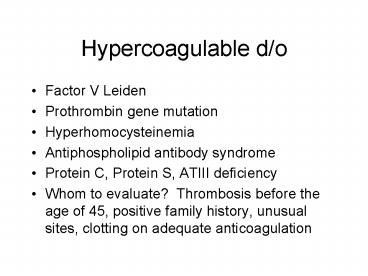Hypercoagulable do - PowerPoint PPT Presentation
1 / 9
Title:
Hypercoagulable do
Description:
Thrombosis before the age of 45, positive family history, unusual sites, ... the legs, mesenteric veins, portal and hepatic veins, cerebral vein thrombosis ... – PowerPoint PPT presentation
Number of Views:121
Avg rating:3.0/5.0
Title: Hypercoagulable do
1
Hypercoagulable d/o
- Factor V Leiden
- Prothrombin gene mutation
- Hyperhomocysteinemia
- Antiphospholipid antibody syndrome
- Protein C, Protein S, ATIII deficiency
- Whom to evaluate? Thrombosis before the age of
45, positive family history, unusual sites,
clotting on adequate anticoagulation
2
Ddx of Bilateral LE edema
- Renal disease acute GN, ARF, CRF, nephrotic
syndrome - Heart Failure biventricular (ischemic), cor
pulmonale - Liver Disease
- Chronic malabsorption with hypoalbuminemia
- Vascular IVC compression or thrombosis, chronic
venous insufficiency, bil. DVTs - Lymphatic obstruction tumor, fibrosis,
infectious - Endocrine/metabolic hypothyroidism,
mineralocorticoid excess - Drugs OCPs, NSAIDs, nifedipine, rosiglitazone
3
Evaluation
- In the setting of acute thrombosis, levels of
protein C, S, and antithrombin III will be
decreased - Protein C and S are vitamin K dependent ATIII
levels are decreased by heparin - The genetic tests (factor V leiden, prothrombin
gene mutation), as well as antiphospholipid aby
assays and homocysteine levels, can be performed
in the acute setting.
4
APC resistance/Factor V Leiden
- The mutation Arg506Gln of Factor V, or Factor V
Leiden, results in a product that is not
susceptible to cleavage by activated protein c. - This results in more Factor V being available to
generate thrombin through the prothombinase
complex. - The anticoagulant activity of activated protein C
is diminished. (the cleaved factor V is a
cofactor with protein S in fibrinolysis.)
5
APC resistance without Factor V Leiden
- Phenotypic resistance to APC can occur in the
absence of the mutation demonstrated in a large
Italian study 1999 of pts with venous
thromboembolism. - --15,109 people screened
- --2134 had resistance of activated proC
- --447 heterozygotes, 7 homozygotes
- Clinical significance of this is unclear
6
APC resistance/Factor V Leiden
- Heterozygosity accounts for 90-95 of cases
- Prevalence ranges from 1 to 8.5 (5)
- Highest in Greece and Sweden (approaches 15)
- Virtually absent in African Americans, Chinese,
Japanese populations - Homozygosity (5 of cases) greater thrombotic
risk
7
APC resistance/Factor V Leiden
- Lifetime probability of developing thrombosis
- --protein S def 8.5X
- --ATIII def 8.1X
- --protein C def 7.3X
- --heterozygous Factor V Leiden 2.2X
- Increased incidence of second thrombotic defects
in pts with Factor V Leiden - Interaction with other risk factors occurs in
OCP, pregnancy, obstetrical complications,
immobilization. - Does not occur in cancer, hip or knee
replacement, PE, medical illness, recent surgery
8
APC resistance/Factor V Leiden
- Types of thrombosis deep veins of the legs,
mesenteric veins, portal and hepatic veins,
cerebral vein thrombosis - Arterial thrombosis not well established.
Unable to find increased incidence in those with
strokes/MIs
9
Treatment
- Extended anticoagulation not helpful unless
- Two or more spontaneous thromboses
- One spontaneous life threatening thrombosis
- One spontaneous thrombosis at an unusual site
(mesenteric, cerebral) - One spontaneous thrombosis in the presence of
more than one thrombophilic condition - Pregnancy SQ heparin or LMWH during the second
or third trimester and continued for 6 weeks into
the postpartum period































